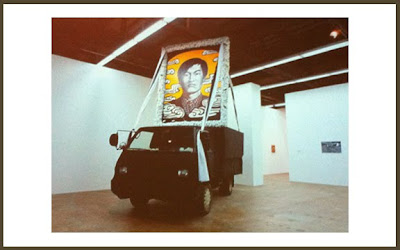Massimiliano Gioni with an artwork by Paul McCarthy
Photo: Marco DeScalzi, Courtesy of the New Museum
As part of Performa 11, Massimiliano Gioni, Associate Director and Director of Exhibitions at the New Museum, participated in a Performa Intensive Public Lecture: On Biennials. The event was hosted by NYU Steinhardt Department of Art and Art Professions at the Barney Buidling. Myself, along with several noteworthy guests including Paolo Canevari, Roberta Smith, and Jerry Saltz amongst others, attended the lecture this past Monday.

RoseLee Goldberg
Founding Director of Performa and Curator RoseLee Goldberg introduced Mr. Gioni giving a brief history on his curatorial experience. The auditorium was dimly lit and standing room only. The lecture coincides with an inaugural course, Performa Intensive, that will run throughout the duration of this years performance biennial. Along with his ongoing work at the New Museum, Massimiliano Gioni also is the Artistic Director of the Nicola Trussardi Foundation in Milan, Italy. He is currently working on the upcoming exhibition which will be opening at the New Museum later this month which will feature the first US survey of artist Carsten Holler (b. 1961, Belgium).

[Fake] Gagosian Gallery, Berlin, 2006
Since the presentation was On Biennials Massimiliano focused on the concept of the Biennal and its rise in popularity. First he discussed the most famous, Venice Biennale which is in its 54th year. He talked about the two main exhibition venues which include the Arsenale and Giardini. The Arsenale is a large contained exhibition space while the Giardini houses individual, country specific pavilions. He loosely compared the two referring to the latter as a Contemporary Art version of Disney’s Epcot Center and a visual chimera. One of his earliest projects was The Zone, organized for the 50th Venice Biennale in 2003. In 2006 he curated the 4th Berlin Biennal with Maurizio Cattelan and Ali Subotnick. This Biennial took place in twelve unconvential sites along Augustrasse in the Mitte section of Berlin, including a “fake” Gagosian Gallery. Gagosian exists in many major cities throughout the world, but not in Berlin. The curators opened the gallery under false pretenses and held exhibitions as part of the Berlin Biennial, using the same font in order to establish visual reference and familiarity. Anyone who knows that Gagosian isn’t officially located in Berlin, will recognize the reflection of the famous Fernsehturm television tower in the sign, as shown in the image above, the tallest structure in Germany and a recognizable symbol in the city.

Interior of [Fake] Gagosian Gallery, Berlin, 2006
The interior of their Gagosian was anything but the familiar white cube of the blue-chip gallery.Exhibitions took place in rooms that housed objects and some original furniture discarded by previous tenants. The inaugural exhibition in the space as part of the 4th Biennale was Berlin Beauties featuring the most well-known, living (however oldest) and most established artists based in Berlin at that time, including Dieter Roth, Dorothy Iannone and Emmett Williams. For Mr. Gioni, there are four important aspects to consider when curating a Biennial exhibition completing the phrase: The exhibition should be…
1. The best you’ve ever seen.
2. Something you’ve never seen before.
3. Something you want to see.
4. Curated as if it were your last.
And added a bit tongue in cheek…
5. Should include at least one full size car.

Installation view, Gwangju Biennale, 2010
Also discussed was the recent 2010 8th Gwangju Biennale, titled 10,000 Lives. The exhibition was quite different from the Berlin Biennal and held in three large museums in the city of Gwangju, Korea versus the raw/naturalistic spaces used in Berlin years previously. An impressive list of international artists were included and the exhibition focused on the concept of Image as Memorial. Massimliano’s experience in Korea differed from past locations due to the lack of ease when verbally communicating. Beyond assistants and translators he found that not many local people communicated in English and in response, 10,000 Lives reflected the social and productive seduction that is part of collaborative effort and working with others to bring a project to fruition.

Installation view, Gwangju Biennale, 2010
In a visual salute to life, several artists works in the Gwangju Biennale featured the dead. Mr. Gioni reference the magic power of a representational, political portrait which functions as a reminder of someone who is no longer present. Whether a photograph, painting or sculpture, the effigy remains long after the physical body is gone. However in the process of remembering or honoring death, work in the exhibition focused on the concept of life.
Be sure to go to the Performa 11 website where you can find a detailed schedule of other upcoming lectures, panels and performances that are not to be missed! Stay tuned for Carsten Holler: Experience, curated by Massimiliano Gioni, with Gary Carrion-Murayari, Associate Curator, and Jenny Moore, Assistant Curatoron view at the New Museum as of October 26th, 2011.
More soon.
xo


 l]
l] 